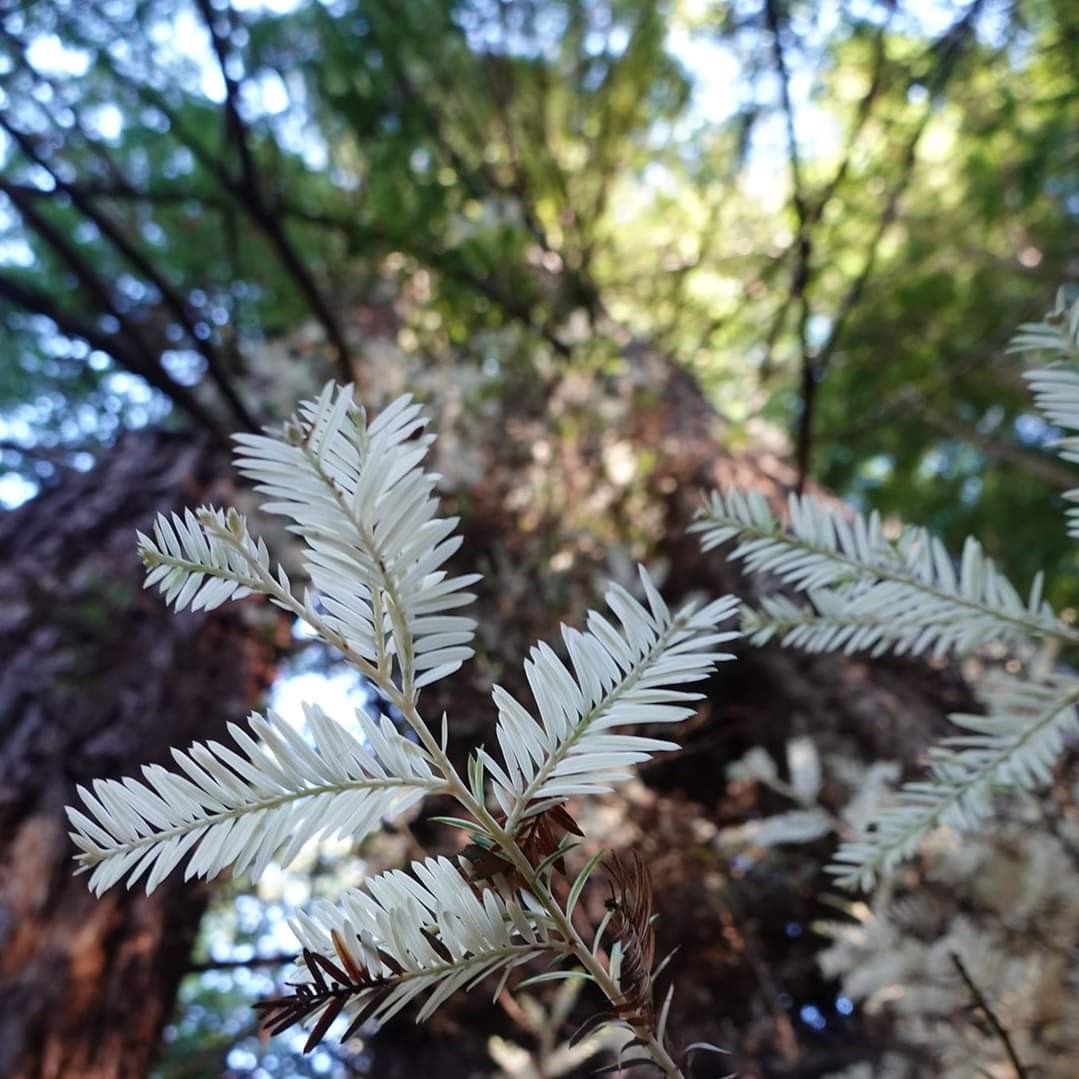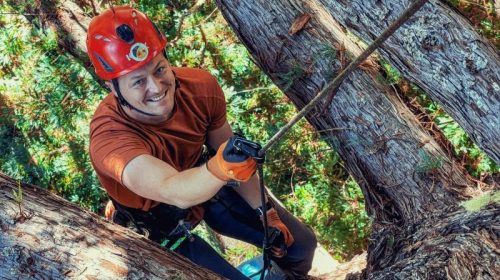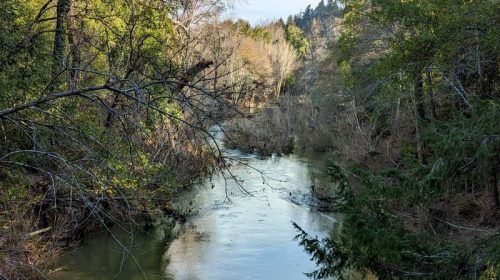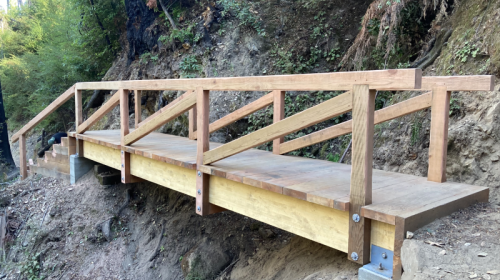Albino Redwoods: The Ghosts of the Forest
Contributors to a Mighty and Interconnected Family
By Gale McCreary
It is a student, crouched in the shamrock-like oxalis plants on the shady redwood forest floor, who first alerts me to the mutant. With careful steps I approach the young man as he poses, one knee on his flattened blaick backpack, the other raised as a writing table for his field notebook. His intent posture warrants that I speak in hushed tones.
“Are you studying something here?” I whisper.
He shoots me a quick and somewhat annoyed glance and answers in an equally quiet voice, “Yes, this albino.”
My eyes drift to the brushy clump in front of him, straining to see a white bird or even a bleached banana slug, but all I see is brown leaf litter from the towering redwood above caught in a cluster of faded needles.
“This is a rare albino redwood,” he clarifies.
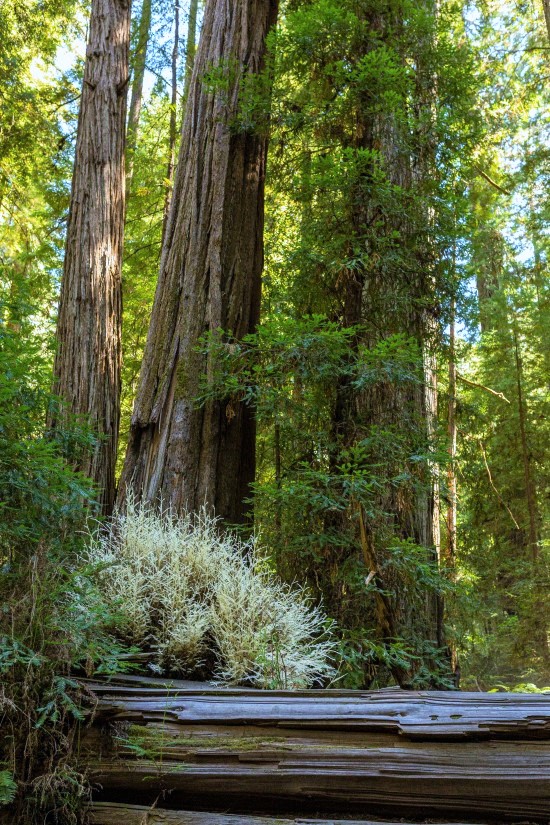
The Coastal Redwood, Sequoia sempervirens, is one of the grandest trees on earth, living over 2,000 years and growing over 350 feet tall. They grow only along the 450-mile coastal fog line of northern California, withstanding the many tests of nature: storms, fires, droughts, earthquakes, and benefitting from the climatic buffering of the Pacific Ocean. It wasn’t until loggers discovered them in the mid-1800s that they began to fall until only 5 percent of the original old-growth giants remain today. Tilting my head back to trace the heavily red barked trunk skyward, I feel small and insignificant. Here in the deep shadows of the Henry Cowell Redwood Grove Loop Trail, I am but a speck on the earth and a blink in time.
The number 14 trail marker points me to the explanation of the albino redwood. I enter the text into Google Translate after inadvertently picking up the German version of the trail guide: “A white redwood? Albino redwoods have chlorophyll-less needles. Without leafy greens, these branches must get their nourishment from the roots of the neighboring tree.” It makes sense — chlorophyll is the green pigmented protein that allows all plants to convert air and water to energy-rich carbohydrates.
“So what are you studying about it?” I ask the student.
“Why it exists,” he replies.
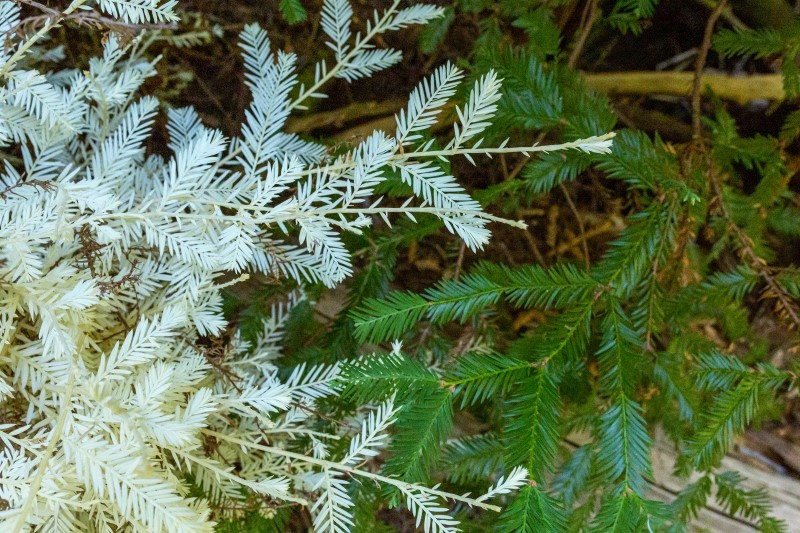
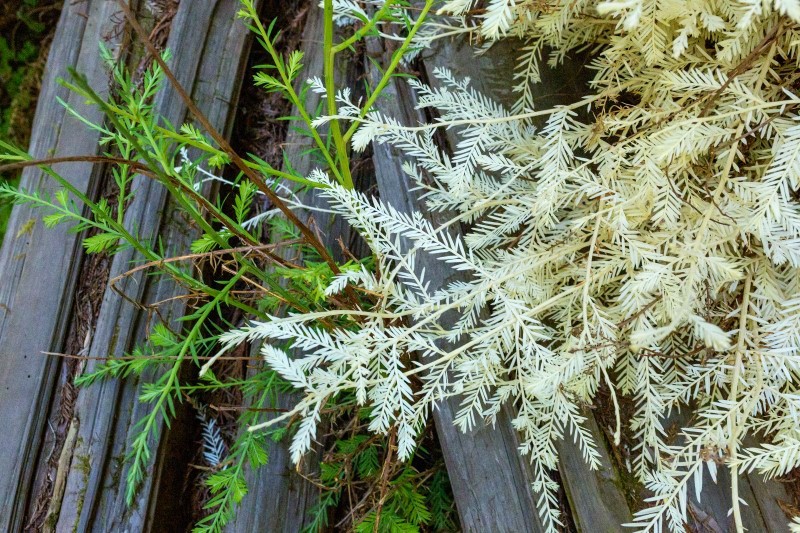
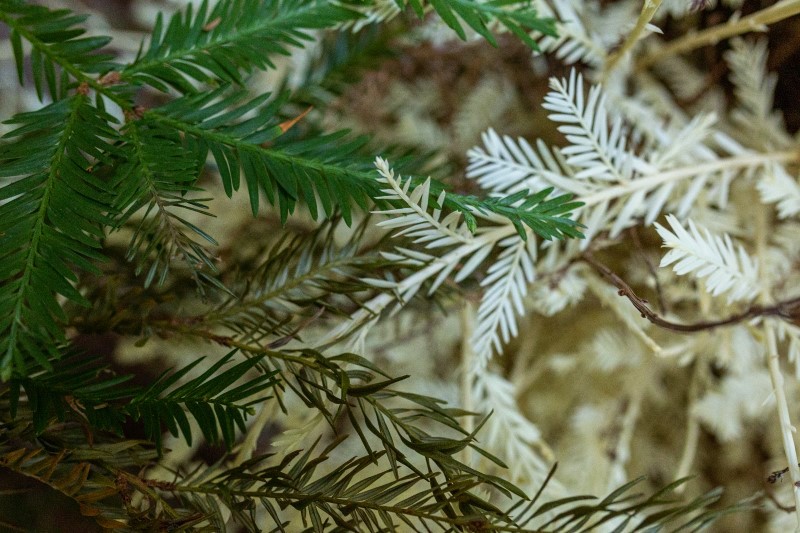
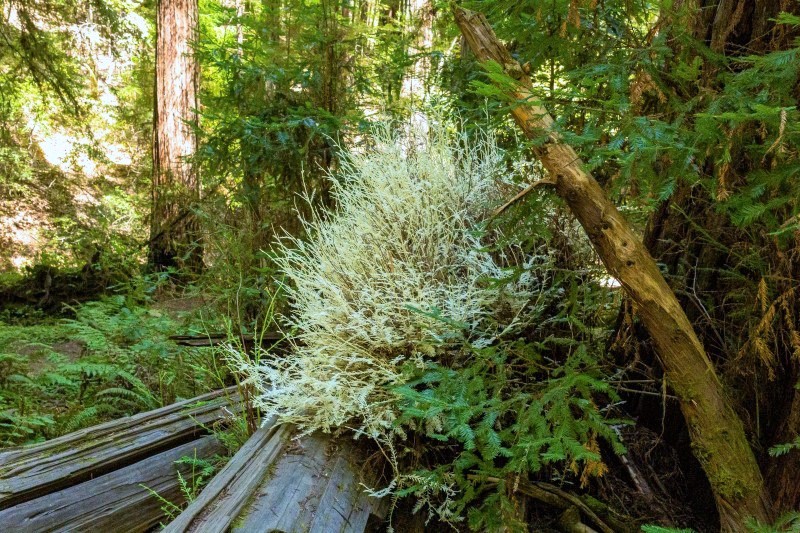
Redwoods are prodigious reproducers and one of the fastest growing conifers. Each year they produce millions of seeds from small rounded cones, hoping for a genetically diverse seedling to take root. Most of the young trees have regenerated from the burls, trunks or root systems of a parent, and hence are genetic clones. The redwood genetics are robust and with 7 times more genes than humans, mutation rates are fairly high. Even so, only 630 albino mutants have been found in 2.2 million acres of redwoods. Their white and waxy needles appear soft and weak next to their hardy green neighbors, and the trees rarely grow more than 20 feet tall. Scruffy and messy, like little Dickens street urchins, the albino trees snuggle among the trunks of their parent and siblings. They are indeed carbon parasites, making me wonder why they exist as well.
Ten years ago as a teen, Zane Moore, now a research botanist at UC Davis, set off to solve the albino redwood mystery. The budding scientist’s childhood interest had been carnivorous plants, as he joyfully fed Venus Fly traps and Pitcher plants with hapless bugs held on the end of tweezers. He recognized that unlike animals, plants cannot move to more favorable locations and must adapt themselves to address change. “If you’re stuck with no way to move to a better food source or climate, you have to use biochemical defenses in order to create resilience,” he explained. “Plants can only randomly tinker with DNA and use resulting mutations to their advantage.”
Through extensive testing and chemical analysis, Moore found the albino’s white needles to hold twice as many heavy metals such as nickel, copper, and cadmium, as the green needles of its host. These molecules are deadly because they poison the pathways that make chlorophyll, making it impossible for the tree to photosynthesize. Moore’s interpretation is that “essentially, the white sprouts are sacrificial branches to remove toxic metals from the environment. While it has no choice in the mutations, the parent keeps only those that help it grow and thrive. For a mutant albino redwood to continue to be fed, its parent has to want to keep it around.”
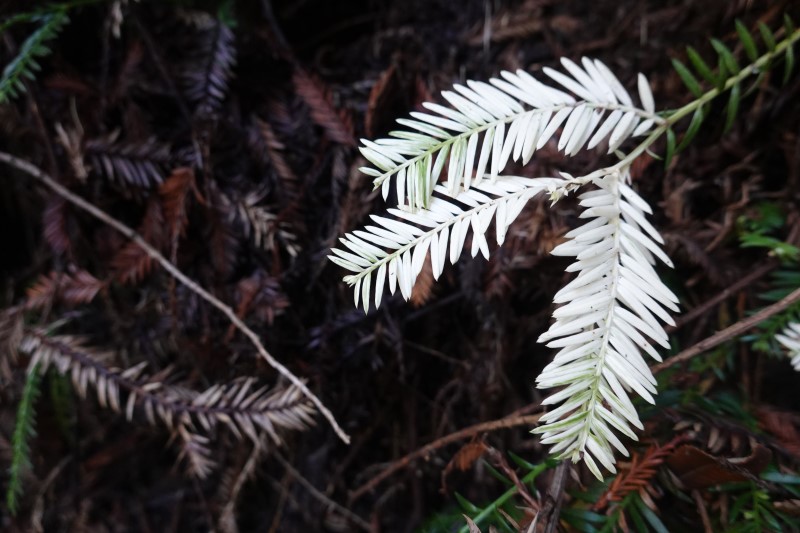
I continue my walk through the quiet paths of the park, my footsteps softened by the spongy redwood duff. The air is still and cool under the whispering canopy. I feel like an African safari guide training my eyes to spot brilliant whiteness instead of camouflaged spots and stripes. A glimmer of light pulls me into a circular ring of trees.
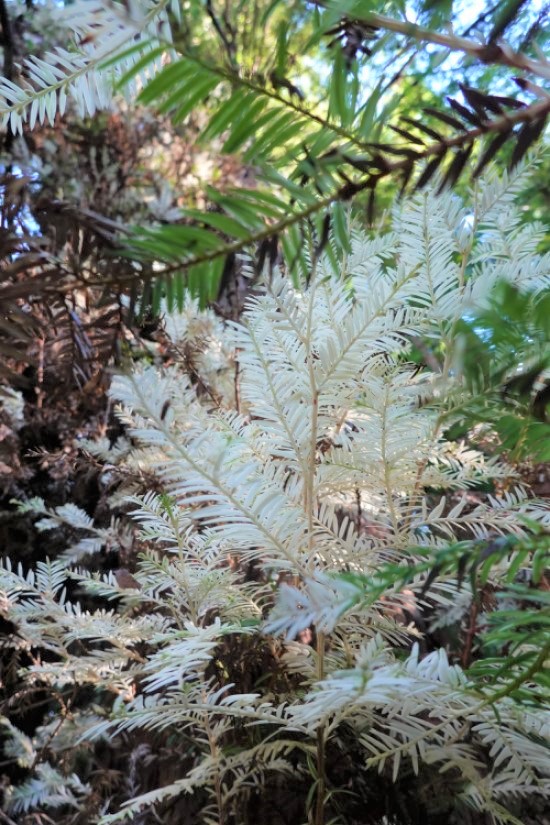
This is called a “fairy ring” or “cathedral circle,” formed from when the mammoth trees of virgin forests were first harvested. From around the butchered trunk still simmering with life, eager sprouts had stretched into the vacant sunlight corridor, competing for a piece of the space left by their felled parent. They grew voraciously so that barely 170 years later they are nearly half of their ancient parents’ height. Only a melting piece of moss-covered stump hints at the matriarch. I inspect it closely for a trace of albino foliage, then check the tangles of new and old stems at the bases of the family of redwoods in the circle. A single tree can have a million variations, and this “ghost” can manifest high on the tree, where the albino mutation may have happened on just one wayward sprout. I gaze up the straight red trunks to a proud green canopy framing the diminishing skylight — no sign of the elusive albino here. I give a little shiver as the first wisps of coastal fog start to creep in. Holding my arms close against the chill, I head back, comforted by a quest that will forever lure my eyes towards brightness among the forest greens, and an understanding that these pallid little redwoods are not orphans after all, but specialized contributors to a mighty and interconnected family.

Gale McCreary is the Founder and Chief Coordinator of SpeechStory, a nonprofit organization focused on helping youth improve their public speaking skills. She previously was Founder and CEO of a healthcare IT company, where she was recognized as Santa Barbara Entrepreneurial Woman of the Year and received Congressional recognition for providing a Family-Friendly work environment. She has a BS in Biology from Stanford University. Gale resides in Felton with horses, ducks, and Australian Shepherds.
Featured photo: Albino Redwoods by Julie Horner
Additional photos: adobe.com
The San Lorenzo Valley Post is your essential guide to life in the Santa Cruz Mountains. We're dedicated to delivering the latest news, events, and stories that matter to our community. From local government to schools, from environmental issues to the arts, we're committed to providing comprehensive and unbiased coverage. We believe in the power of community journalism and strive to be a platform for diverse voices.

